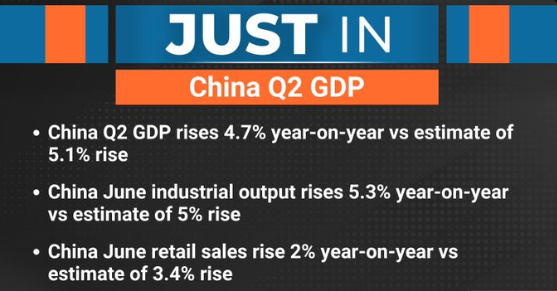No one believes anything out of China regarding any kind of economic data. They have lied for decades, so when they show numbers that are not very good for their nation, you can be certain it is far worse for the Communist state. If it were not for the 500 plus billion yearly stolen in Intellectual Property stolen from the U.S., the nation would be a basket case. But let’s entertain their official numbers.
China’s National Bureau of Statistics reported on Monday that the country’s second-quarter GDP grew by 4.7% year on year, falling short of the anticipated 5.1% growth projected by a Reuters poll. This data highlights ongoing economic challenges as the nation strives to recover and stabilize.
⚡#China GDP data:
Q2 GDP 4.7% y/y [Est.+5.1%]
1H GDP 5.0% y/y [Est.+5.2%]
1️⃣June retail sales 2.0% y/y [Est.3.3%]
2️⃣June industrial growth 5.3% y/y [Est.5.0%]
3️⃣Jan-Jun fixed asset investment 3.9% y/y [Est.3.9%]
June Unemployment 5.0% [Prev. 5.0%]#EconTwitter 🇨🇳
1/ Thread pic.twitter.com/s814qS7rTd— CN Wire (@Sino_Market) July 15, 2024
June retail sales also underperformed, rising only 2% compared to the expected 3.3% growth. Louise Loo, Lead Economist at Oxford Economics, noted that discretionary retail spending declined sharply, marking the steepest drop since the April 2022 lockdowns in Shanghai.
Despite these challenges, Oxford Economics revised China’s GDP growth forecast for 2024 to 4.8%, up from the 4.4% estimated in December 2023. Meanwhile, industrial production showed a positive trend, growing by 5.3% year on year in June, surpassing the 5% forecast. High-tech manufacturing experienced an 8.8% increase in value added, highlighting a sector-specific strength.
Urban fixed asset investment for the first half of the year rose by 3.9%, aligning with expectations. However, investment in infrastructure and manufacturing slowed compared to the previous month, and real estate investment continued to decline at a rate of 10.1%.
The data showed that housing-related wealth in China increased by 2.2% in 2023, a significant drop from the 13% average annual growth between 2016 and 2021. The urban unemployment rate remained steady at 5% in June. Youth unemployment, particularly for those aged 16 to 24 not in school, remained high at 14.2% as of May.
Average per capita disposable income for urban residents in the first half of the year was 27,561 yuan ($3,801), reflecting a nominal growth of 4.6% from the previous year. Rural disposable income grew at a faster rate of 6.8%, but at 11,272 yuan, it remained significantly lower than urban income.
The National Bureau of Statistics emphasized the need to invigorate the market and stimulate internal growth, calling for efforts to consolidate and enhance economic recovery momentum. The absence of a press conference for the data release coincided with the start of China’s high-level policy meeting, the Third Plenum.
News Alert | China Eco Data: Q2 GDP growth at 4.7% YoY; est of 5.1% growth#China #ChinaEcoData pic.twitter.com/XSm8W3FohR
— ET NOW (@ETNOWlive) July 15, 2024
Bruce Pang, chief economist and head of research for Greater China at JLL, expressed anticipation for how the plenary meeting might boost confidence and stabilize expectations. He noted that more work is required for China to achieve its 5% growth target, given the first half’s 5% expansion and the likelihood of slower growth in the latter half of the year.
China’s GDP grew by 5.3% year on year in real terms during the first quarter. In nominal terms, GDP growth was 3.97% in the first quarter and 4.01% for the first half of the year, according to Wind Information data.
China’s exports exceeded expectations, rising by 8.6% year on year, while imports fell by 2.3%, missing growth forecasts. Xu Hongcai, deputy director of the Economics Policy Commission at the China Association of Policy Science, suggested increasing fiscal support and easing monetary policy in the second half of the year to counter uncertainties stemming from trade tensions.
Retail sales for the first half of the year rose by 3.7%, with online sales of physical goods increasing by 8.8%. Services sector sales grew by 7.5%. However, cosmetics sales plummeted by 14.6% in June, making it the worst-performing category. Other sectors, such as communication equipment, sports goods, and alcohol, saw varying degrees of sales increases.
China’s credit data revealed a significant drop in the growth of broad money supply and new yuan loans in the first half of the year compared to 2023. Household loans increased by 1.46 trillion yuan ($200 billion), nearly half of the 2.8 trillion yuan recorded last year. Business loans grew by 11 trillion yuan, slightly less than the 12.81 trillion yuan from the previous year.
China’s economic growth slowed to 4.7% in the second quarter from a year earlier, likely amplifying calls for more effective stimulus as Communist Party leaders begin their highly anticipated third plenum in Beijing.https://t.co/3uYMj03gRj pic.twitter.com/HzYmcwX654
— Nikkei Asia (@NikkeiAsia) July 15, 2024
Goldman Sachs analysts noted that June’s money and credit data indicated weak credit demand, emphasizing that the People’s Bank of China (PBOC) is focusing on enhancing monetary policy transmission over aggregate credit growth. They anticipate that the growth of new CNY loans and M2 may gradually slow further.
Major Points:
- China’s Q2 GDP grew by 4.7%, missing the 5.1% forecast.
- June retail sales rose by 2%, below the 3.3% expected.
- Industrial production in June exceeded expectations, growing by 5.3%.
- Urban fixed asset investment and rural disposable income showed moderate growth.
- China’s exports rose 8.6% year on year, while imports fell by 2.3%.
James Kravitz – Reprinted with permission of Whatfinger News



